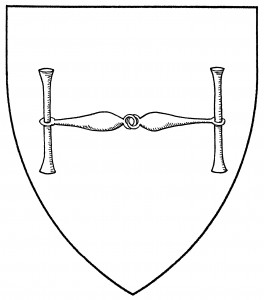A snaffle-bit is the part of the bridle which goes into the horse’s mouth; the rider controls the horse through direct pressure, without leverage. It’s a period charge, found in the arms of von Wierrant, 1605 [Siebmacher 40], and of Kasattel, mid-16th C. [BSB Cod.Icon 392d:542; cf. Parker 63]. It’s sometimes blazoned, a bit redundantly, as a “riding snaffle-bit”. The snaffle-bit is fesswise by default.
Period forms of the snaffle-bit have a bar or curb at either end, to keep it from slipping from the horse’s mouth; and a ring, to attach the reins. While a snaffle-bit could be a solid bar, by far its most usual form is jointed in the center (as in the illustration); it is thus usually blazoned a “broken snaffle-bit” in the Society. (“Broken” here refers to the joint; it doesn’t mean the bit is fracted.) Society armory often emphasizes the joint by arranging the snaffle-bit in chevron.
There’s one Society example of a “double-strand snaffle-bit”, which is simply a broken snaffle-bit whose central part is made from two braided wires rather than a solid metal bar.
For related charges, see bridle.
Shishido Tora bears: Per bend sinister gules and sable, a snaffle-bit Or and an eagle argent.
Elizabeth de la Vigne bears: Vert, a broken snaffle-bit chevronwise argent and in base a sun Or.
Alail Horsefriend bears as a badge: A double-strand snaffle-bit fesswise.
